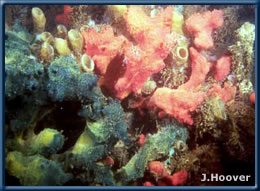

Haliclona caerulea

Gelliodes fibrosa

Suberites zeteki

Zygomycale parishii

Mycale armata
Suberites zeteki
 Lobate
sponge
Lobate
sponge
Phylum Porifera
Class Demospongiae
Order Hadromerida
Family Suberitidae
Description
Growth Form
Encrusting to massive, usually with large lobate or digitate projections.
Color
External color variable, usually red or red-orange, but also yellow, dark
green, greenish purple, or turquoise; internal color always yellow-ochre.
Texture and Surface Features
Texture dense, flexible, rubbery, but easy to tear; like cheese. Surface
generally smooth, some specimens with goose-bumps
 Spicules
Spicules
Straight sharply pointed tylostyles, large variation in size 300-700 mm,
some smaller ones with irregularly shaped or lumpy heads; although ectosome
consists of brushes of smaller tylostyles of nearly uniform size (300
mm), no distinct size classes are evident
Habitat
Common as fouling in harbors, especially those with some estuarine conditions,
and in Kaneohe Bay, primarily on floating docks, dock pilings and mangrove
roots, also on hulls of ships.
Distribution
Hawaiian Islands
Oahu - all leeward harbors and Kaneohe Bay
Kauai - Nawiliwili Boat Harbor
Native Range
Caribbean or west coast Panama
Present Distribution
Caribbean, Panama, Hawaiian Islands, Guam
Mechanism of Introduction
Unintentional introduction, most likely as fouling on ships' hull.
Impact
Fouling organism. Ecological impact unstudied, some competition for space
with native species likely.
Ecology
Reproduction
Like all sponges, S. zeteki is capable of
asexual reproduction by fragmentation of the adult. Details regarding
sexual reproduction of this species are unknown. (See Reproduction
of Haliclona caerulea for general description
of sponge reproduction.)
Feeding
Sponges are filter feeders, continuously circulating water through their
bodies. Microscopic food particles are removed from water by specialized
collar cells. Digestion is intracellular.
Remarks
De Laubenfels (1950) thought S. zeteki to
be the most abundant in Hawaii, especially in shallow-water protected
environments such as boat harbors and embayments. Recent observations
of sponge populations in these habitats around Oahu, suggest that the
more recently introduced sponge, Mycale armata,
not present during de Laubenfels' time, is now more abundant and widespread.
De Laubenfels (1950) considered the Hawaiian specimens to be identical
to Laxosuberites zeteki which he described in 1936, found at both ends
of the Panama Canal. We have examined the holotype of L.
zeteki and concur with de Laubenfels' determination.
Mycale cecilia de Laubenfels 1936, a common
West Indian species, is also very common in shallow water locations such
as Honolulu and Pearl Harbors, leading him to speculate that: "The
2 Panamanian forms conceivably may have been bought to Hawaii on ship
bottoms, one being abundant on those [ships] dry-docked at Pearl Harbor,
or conversely, they may have been taken from Hawaii to Panama."
References
De Laubenfels, M.W. 1950. The sponges of Kaneohe Bay, Oahu. Pac. Sci.
4(1): 3-36.
© 2002 Hawaii Biological Survey, Bishop Museum
contact